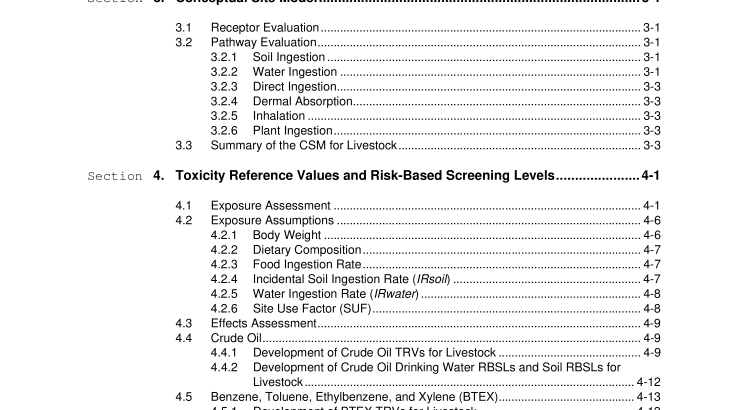API Publ 4733:2004 pdf free download.Risk-Based Screening Levels for the Protection of Livestock Exposed to Petroleum Hydrocarbons
3.2.3 Direct Ingestion Cattle may directly ingest crude oil and other petroleum compounds from pools of oil formed by leaking pipelines or storage tanks (Edwards and Zinn 1979; Coppock et al. 1995; CCME 2000) due to curiosity (particularly in young calves; Edwards 1985b), or to add salt to their diet (Edwards 1985b, Coppock et al. 1995). Reported cases include steers consuming petroleum distillate, drinking from a slush pit, and drinking petroleum from puddles near a tank battery (Edwards and Zinn 1979). Oil and natural gas industry guidance (API 1997) and many regulatory agencies (e.g., the Railroad Commission of Texas 1993) stress the importance of removing free-oil accumulations on the ground that animals could potentially ingest.
3.2.4 Dermal Absorption Dermal absorption of petroleum hydrocarbons in livestock is considered a minor exposure pathway because of their thick coats (CCME 2000). While methods are available to assess dermal exposure to humans, data necessary to estimate dermal exposure are generally not available for livestock or wildlife (EPA 1993). Additionally, dermal exposure has been shown to be negligible for most terrestrial mammals (EPA 2000).
3.2.5 Inhalation According to CCME (2000), inhalation of petroleum hydrocarbons is also a minor exposure pathway for livestock. Inhalation of petroleum hydrocarbons was assumed to be negligible for two reasons: (1) due to the assumed presence of vegetation on grazing lands, exposure of contaminated surface soils to winds and resulting aerial suspension of contaminated dust particulates would be minimized, and (2) most volatile organic compounds (VOCs)Ñthe contaminants most likely to present a risk through inhalationÑget rapidly diluted and dispersed in ambient air, making significant exposure to VOCs through inhalation unlikely. In situations where inhalation exposure is believed to be more significant, evaluation of this pathway should be considered.
3.2.6 Plant Ingestion Exposure to petroleum hydrocarbons through ingestion of plants is considered a minor pathway (CCME 2000). The authors explain that although the ingestion rates of plants are high for livestock, plants are considered a minor contributor to this proportion, due to the limited phytoaccumulation (i.e., a process by which plants accumulate contaminants into roots and above ground shoots or leaves) potential of petroleum hydrocarbons (CCME 2000; Alberta Environment 2001a).
3.3 Summary of the CSM for Livestock If the CSM can identify any complete and significant exposure pathway(s) for livestock receptors at a site, then the next step would be to conduct a screening-level risk assessment. However, another factor to consider in determining whether there is need to assess livestock risks is the size of the contaminated area or release relative to the size of the grazing area. This is referred to as a site use factor (explained further in the following section). A small affected area (e.g. less than one acre) is unlikely to result in significant risks to herds of livestock and may not warrant a screening-level risk assessment (Texas Natural Resource Conservation Commission [TNRCC] 2000 and Pennsylvania Department of Environmental Protection [PADEP] 1998). Cumulative risks can be estimated for livestock receptors exposed to petroleum hydrocarbons via multiple exposure pathways (for example, via soil ingestion and water ingestion at a site).
A screening-level risk assessment uses a conservative approach to determine any potential risk to receptors exposed to contaminants at a site which includes comparing exposure levels of contaminants from a site to appropriate threshold values (i.e., toxicity values and guidelines). To characterize potential risks to livestock, petroleum hydrocarbon exposure levels from a site can be compared to petroleum hydrocarbon threshold levels protective of livestock.
As explained earlier, the approach described in this report is general, not site-specific. Therefore, threshold values were developed for the primary exposure pathways: 1) drinking water ingestion, and 2) incidental soil ingestion. Although, direct ingestion was also considered a significant exposure pathway (Figure 1), site-specific parameters are required to develop threshold values for this pathway and therefore, were not addressed in this report.API Publ 4733 pdf download.API Publ 4733:2004 pdf free download
